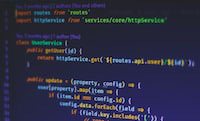
Course9012
Course Introduction:Introduction: "MySQLi Extension Library Video Tutorial" explains the specific use and precautions of MySQLi from two aspects: object-oriented and process-oriented. Finally, through a practical drill of the no-refresh comment system, it analyzes in detail how to use MySQLi to complete the database in actual development. operation.

Course2857
Course Introduction:Course introduction: 1. Cross-domain processing, token management, route interception; 2. Real interface debugging, API layer encapsulation; 3. Secondary encapsulation of Echarts and paging components; 4. Vue packaging optimization and answers to common problems.

Course1795
Course Introduction:Apipost is an API R&D collaboration platform that integrates API design, API debugging, API documentation, and automated testing. It supports grpc, http, websocket, socketio, and socketjs type interface debugging, and supports privatized deployment. Before formally learning ApiPost, you must understand some related concepts, development models, and professional terminology. Apipost official website: https://www.apipost.cn

Course5521
Course Introduction:(Consult WeChat: phpcn01) The comprehensive practical course aims to consolidate the learning results of the first two stages, achieve flexible application of front-end and PHP core knowledge points, complete your own projects through practical training, and provide guidance on online implementation. Comprehensive practical key practical courses include: social e-commerce system backend development, product management, payment/order management, customer management, distribution/coupon system design, the entire WeChat/Alipay payment process, Alibaba Cloud/Pagoda operation and maintenance, and project online operation. .....

Course5172
Course Introduction:(Consult WeChat: phpcn01) Starting from scratch, you can solve conventional business logic, operate MySQL with PHP to add, delete, modify, and query, display dynamic website data, master the MVC framework, master the basics of the ThinkPHP6 framework, and learn and flexibly master all knowledge involved in PHP development. point.
How to roll back to PHP version 8.1: Docker phpdockerio/php:8.1-fpm build uses PHP version 8.2
2023-11-05 09:52:26 0 1 282
How to run python script from HTML in google chrome?
2023-11-02 23:34:24 0 1 400
Install/enable php8.1's sqlsrv and pdo_sqlsrv drivers on ubuntu20.0
2023-11-01 11:06:13 0 2 283
Identify performance limitations in JavaScript
2023-10-31 20:47:17 0 1 229
Connect Visual Studio Code to a remote MySQL database: Simplify the connection process
2023-10-24 20:41:24 0 2 231

Course Introduction:PHP extension refers to extending the functions of PHP by customizing the PHP extension library. The main purpose is to meet the needs of the program in different scenarios. This article will explain the writing of PHP extensions through a series of coding cases to achieve the needs of customized functions. Types of extensions There are many types of PHP extension libraries, the most common of which are: Function extension library: Add new functions to PHP through extensions, and these new functions can be called directly in PHP scripts. Class extension library: Create new classes or modify existing classes through extensions, and add new methods or properties to these classes through extensions. Constant extension library: add new constants to PHP through extensions, and these constants can be used directly in scripts. Structure of an extension library A typical PHP extension library consists of the following parts: Extension:
2024-02-19 comment449

Course Introduction:With the development of the Internet, PHP has gradually become an important programming language in Web development and is widely used. The extension development of PHP is one of the important means to improve the performance and functionality of PHP applications. This article will start with the basics and introduce how to write your own PHP extensions to help developers better understand the process and specifications of PHP extension development. Introduction to PHP extensions In PHP, an extension refers to a dynamic library written in C language, which can increase the functionality and performance of PHP, or directly extend the core of PHP. P
2023-05-11 comment 01388

Course Introduction:First introduction to PHP extensions A php extension is a code written in C language that can extend the functionality of PHP. It can be achieved by writing a PHP extension module and then using functions to load it into PHP. PHP extensions can be used for various purposes, such as: Adding new functions or classes to PHP extensions PHP’s built-in data types Improving the performance of PHP Integrating with other languages or systems Creating PHP extensions The process of creating a PHP extension involves the following steps: Create a new C project. Contains necessary PHP header files. Define functions and classes for PHP extension modules. Compile PHP extension module. Load PHP extension modules into PHP. Here is an example of a simple PHP extension module: #include
2024-02-19 comment 0634

Course Introduction:PHP扩展名用于扩展PHP内核功能,有不同类型:核心扩展名(.so、.dll、.dylib)其他扩展名(.php:脚本文件,.inc:包含文件,.phtml:HTML模板,.phar:存档文件,.pcov:代码覆盖率,.php-fpm:配置文件)扩展名选择取决于平台、功能和安全因素。使用正确的扩展名命名文件以确保PHP正确识别和处理。
2024-08-02 comment748

Course Introduction:PHP extensions include PDO extension, GD extension, OpenSSL extension, Curl extension, Xdebug extension, Redis extension, Memcached extension, MongoDB extension, Swoole extension, Yaf extension, etc. Detailed introduction: 1. PDO is a unified database access interface provided by PHP, which can connect to multiple types of databases; 2. The GD extension provides a large number of image processing functions, which is very suitable for developing websites that require image processing functions; 3. OpenSSL extension wait.
2023-07-12 comment 01640